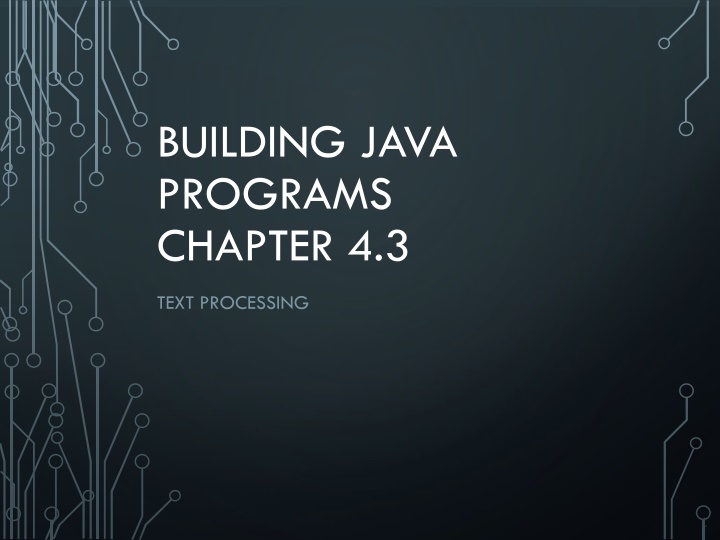
Text Processing in Java: Char, String, and Comparison Fundamentals
Learn about char data type, string manipulation, and comparison in Java programming. Explore how to work with individual characters, access characters in strings, and compare char values effectively. Enhance your understanding of ASCII values and the differences between char and string types to improve your Java coding skills.
Download Presentation

Please find below an Image/Link to download the presentation.
The content on the website is provided AS IS for your information and personal use only. It may not be sold, licensed, or shared on other websites without obtaining consent from the author. If you encounter any issues during the download, it is possible that the publisher has removed the file from their server.
You are allowed to download the files provided on this website for personal or commercial use, subject to the condition that they are used lawfully. All files are the property of their respective owners.
The content on the website is provided AS IS for your information and personal use only. It may not be sold, licensed, or shared on other websites without obtaining consent from the author.
E N D
Presentation Transcript
BUILDING JAVA PROGRAMS CHAPTER 4.3 TEXT PROCESSING 1
TYPE CHAR char : A primitive type representing single characters. Each character inside a String is stored as a char value. Literal char values are surrounded with apostrophe (single-quote) marks, such as 'a' or '4' or '\n' or '\'' It is legal to have variables, parameters, returns of type char char letter = 'S'; System.out.println(letter); // S char values can be concatenated with strings. char initial = 'P'; System.out.println(initial + " Diddy"); // P Diddy 2
THE CHARAT METHOD The chars in a String can be accessed using the charAt method. String food = "cookie"; char firstLetter = food.charAt(0); // 'c' System.out.println(firstLetter + " is for " + food); System.out.println("That's good enough for me!"); You can use a for loop to print or examine each character. } Output: C S E String major = "CSE"; for (int i = 0; i < major.length(); i++) { char c = major.charAt(i); System.out.println(c); 3
CHAR VS. INT All char values are assigned numbers internally by the computer, called ASCII values. Examples: 'A' is 65, 'a' is 97, Mixing char and int causes automatic conversion to int. 'a' + 10 is 107, To convert an int into the equivalent char, type-cast it. (char) ('a' + 2) is 'c' 'B' is 66, 'b' is 98, ' ' is 32 '*' is 42 'A' + 'A' is 130 4
CHAR VS. STRING "h" is a String 'h' is a char (the two behave differently) String is an object; it contains methods String s = "h"; s = s.toUpperCase(); // 'H' int len = s.length(); // 1 char first = s.charAt(0); // 'H' 5
CHAR VS. STRING char is primitive; you can't call methods on it char c = a'; c = c.toUpperCase(); // ERROR: "cannot be dereferenced" String s = a"; What is s + 1 ? What is c + 1 ? What is s + s ? What is c + c ? 6
COMPARING CHAR VALUES You can compare char values with relational operators: 'a' < 'b' and 'X' == 'X' and 'Q' != 'q' An example that prints the alphabet: for (char c = 'a'; c <= 'z'; c++) { System.out.print(c); } 7
COMPARING CHAR VALUES You can test the value of a string's character: String word = console.next(); if (word.charAt(word.length() - 1) == 's') { System.out.println(word + " is plural."); } 8
STRING/CHAR QUESTION A Caesar cipher is a simple encryption where a message is encoded by shifting each letter by a given amount. e.g. with a shift of 3, A D, H K, X A, and Z C Write a program that reads a message from the user and performs a Caesar cipher on its letters: Your secret message: Brad thinks Angelina is cute Your secret key: 3 The encoded message: eudg wklqnv dqjholqd lv fxwh 9
STRINGS ANSWER 1 // This program reads a message and a secret key from the user and // encrypts the message using a Caesar cipher, shifting each letter. import java.util.*; public class SecretMessage { public static void main(String[] args) { Scanner console = new Scanner(System.in); System.out.print("Your secret message: "); String message = console.nextLine(); message = message.toLowerCase(); System.out.print("Your secret key: "); int key = console.nextInt(); encode(message, key); } ... 10
STRINGS ANSWER 2 // This method encodes the given text string using a Caesar // cipher, shifting each letter by the given number of places. public static void encode(String text, int shift) { System.out.print("The encoded message: "); for (int i = 0; i < text.length(); i++) { char letter = text.charAt(i); // shift only letters (leave other characters alone) if (letter >= 'a' && letter <= 'z') { letter = (char) (letter + shift); // may need to wrap around if (letter > 'z') { letter = (char) (letter - 26); } else if (letter < 'a') { letter = (char) (letter + 26); } } System.out.print(letter); } System.out.println(); } } 11
